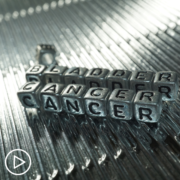Disease Monitoring: Is My AML Treatment Working?
Disease Monitoring: Is My AML Treatment Working? from Patient Empowerment Network on Vimeo.
Dr. Eytan Stein explains how AML treatment effectiveness is monitored and why it’s essential for patients to report any symptoms or side effects to their healthcare team.
Dr. Eytan Stein is a hematologist oncologist at Memorial Sloan Kettering Cancer Center and serves as Director of the Program for Drug Development in Leukemia in Division of Hematologic Malignancies. Learn more about Dr. Stein, here.
Related Resources:

|

|

|
Transcript:
Katherine Banwell:
Once treatment has begun, Dr. Stein, how do you know if it’s working?
Dr. Eytan Stein:
So, that’s a good question. So, the good thing about acute myeloid leukemia when it comes to understanding what’s going on, you know, it’s a disease of the bone marrow cells. And we do bone marrow biopsies to see how things are doing. But no one likes a bone marrow biopsy. It can be a somewhat uncomfortable procedure.
Katherine Banwell:
How often would a patient need to have a biopsy?
Dr. Eytan Stein:
Yeah, so they have bone marrow biopsies at diagnosis, and then they often will have bone marrow biopsies two weeks to a month later.
And then, if they’re in remission, basically any time you think if you want to check to see if they’re in remission or if you suspect the patient is relapsing. Then, you would do a bone marrow biopsy. But what I was getting at is that but you have blood. And the blood is kind of like the bellwether of what’s going on in the bone marrow.
So, the analogy I use for my patients is, you know, when you’re driving your car and you have – you know, you don’t open the hood every day to make sure the car is running okay. You know, you’re driving your car, and if your car starts making a funny clinking sound, that’s when you open the hood.
So, the blood is like the clinking sound. If you see something going wrong in the blood, that’s when you know you’ve got to open the hood and look under the hood. If the car is running just fine and you don’t see anything wrong in the blood, using the analogy, maybe you don’t need to do a bone marrow biopsy.
Katherine Banwell:
What if a treatment isn’t working? What if it stops working or if the patient relapses? What do you do then?
Dr. Eytan Stein:
Yeah, so when a patient relapses, which unfortunately happens more than we want it to, it’s important number one to do another bone marrow biopsy and at that point, do that mutational testing again because the mutations that are present at the time of diagnosis are not necessarily going to be present at the time of relapse, and sometimes, a new mutation might occur at the time of relapse.
And again, what that mutational profile shows can help determine what the next best treatment for the patient is. There might be standard-of-care therapies. More chemotherapy might be recommended.
When a patient relapses, I usually – excuse me – try to get them on a clinical trial because that’s the point where I think clinical trial drugs really have potentially major benefit for the patients, to help get them back into remission.


![[ACT]IVATED AML Resource Guide [ACT]IVATED AML Resource Guide](https://powerfulpatients.org/wp-content/uploads/ACTIVATED-AML-Resource-Guide-180x180.png)







